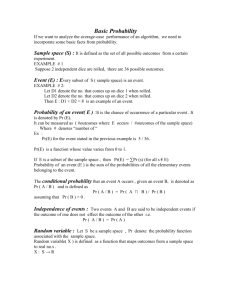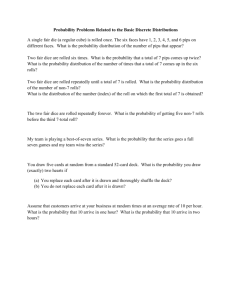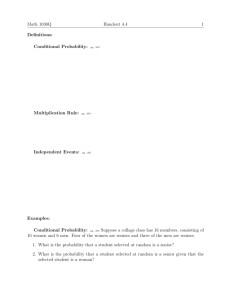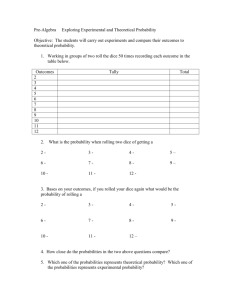1 Generalizing the addition and multiplication rules
advertisement
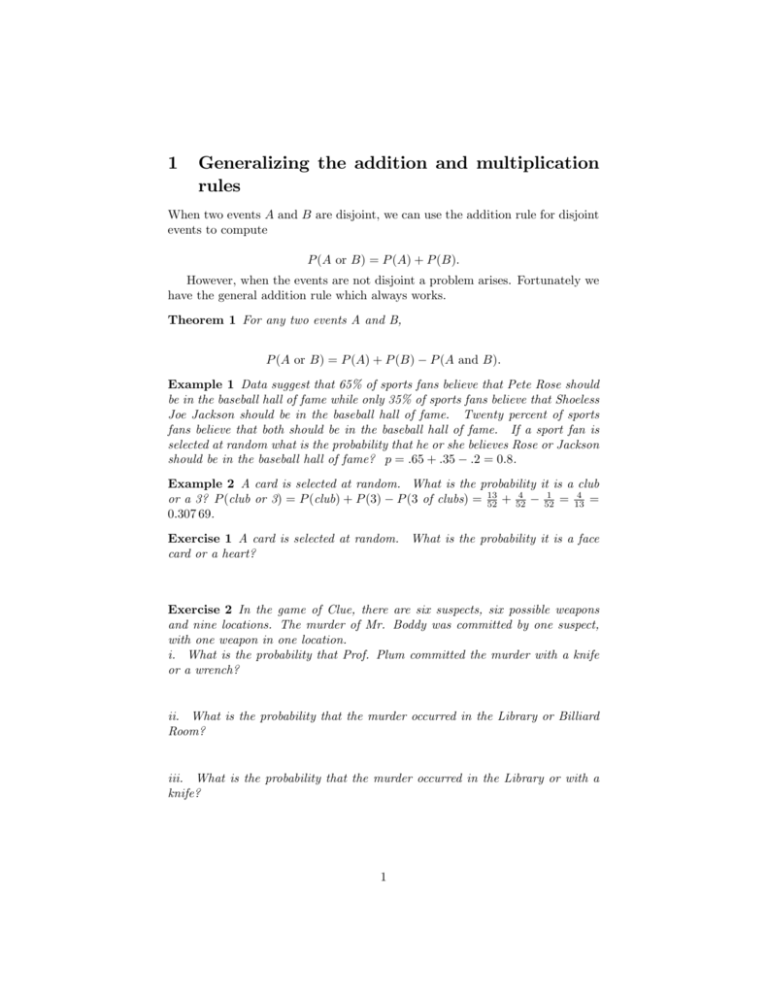
1 Generalizing the addition and multiplication rules When two events A and B are disjoint, we can use the addition rule for disjoint events to compute P (A or B) = P (A) + P (B): However, when the events are not disjoint a problem arises. Fortunately we have the general addition rule which always works. Theorem 1 For any two events A and B, P (A or B) = P (A) + P (B) P (A and B): Example 1 Data suggest that 65% of sports fans believe that Pete Rose should be in the baseball hall of fame while only 35% of sports fans believe that Shoeless Joe Jackson should be in the baseball hall of fame. Twenty percent of sports fans believe that both should be in the baseball hall of fame. If a sport fan is selected at random what is the probability that he or she believes Rose or Jackson should be in the baseball hall of fame? p = :65 + :35 :2 = 0:8. Example 2 A card is selected at random. What is the probability it is a club 4 1 4 or a 3? P (club or 3) = P (club) + P (3) P (3 of clubs) = 13 52 + 52 52 = 13 = 0:307 69. Exercise 1 A card is selected at random. What is the probability it is a face card or a heart? Exercise 2 In the game of Clue, there are six suspects, six possible weapons and nine locations. The murder of Mr. Boddy was committed by one suspect, with one weapon in one location. i. What is the probability that Prof. Plum committed the murder with a knife or a wrench? ii. What is the probability that the murder occurred in the Library or Billiard Room? iii. What is the probability that the murder occurred in the Library or with a knife? 1 Exercise 3 You roll a pair of dice. What is the probability that you roll doubles or a sum less than or equal to 5? When two events A and B are independent, we can use the multiplication rule for independent events to compute P (A and B) = P (A) P (B): However, when the events are dependent a problem arises. Fortunately we have the general multiplication rule which always works. Before stating the general multiplication rule we must …rst investigate conditional probability. A probability that takes into account a given condition is called a conditional probability. De…nition 1 The probability that event A occurs given that event B has already taken place is called the conditional probability of A given B and is denoted P (AjB). Exercise 4 A pair of dice is thrown one at a time. Let A be the event that the sum of 9 is rolled. Let B be the event that the …rst die thrown is a 2. Let C be the event that the …rst die thrown is a 5. Let D be the event that the sum of 7 is rolled. i. What is the probability the sum of the dice is 9? ii. What is the probability the sum of the dice is 9, given that the …rst die rolled is 2? iii. What is the probability the sum of the dice is 9, given that the …rst die rolled is 5? iv. What is the probability the sum of the dice is 7? v. What is the probability the sum of the dice is 7, given that the …rst die rolled is 2? vi. What is the probability the sum of the dice is 7, given that the …rst die rolled is 5? 2 Very formally we can compute conditional probabilities with P (AjB) = P (A andB) : P (B) You’ll note that we don’t need to worry about division by 0 since by de…nition the event B has already occurred while we are computing P (AjB). Exercise 5 A study at a local bar found people of various ages playing games. 21-29 30-39 40-49 50 and older Total Darts 4 12 15 6 37 Pool 8 17 16 11 52 Karaoke 17 5 0 1 23 Total 34 31 18 112 29 Find the probability that a randomly selected person... plays darts; is 21-29; is 21-29 given that they are playing darts; is 21-29 given that they are singing karaoke; is singing karaoke given that they are 21-29; is 30-39 and playing pool; is playing pool given that they are 30-39. Theorem 2 For any two events A and B, P (A and B) = P (A) 3 P (BjA): Exercise 6 An box contains 3 white balls, 4 red balls and 5 black balls. A ball is picked, its color recorded but is not returned to the box. Another ball is then selected and its color recorded. Find the probability that 2 black balls are selected. Find the probability that 2 balls of the same color are selected. 2 Common Birthdays A quick check of the 2010 Philadelphia Phillies1 roster shows that two di¤erent pairs of players share the same birthday (disregarding year). 1 Those who have read Dr. DeMaio’s sports biography know that he checked the Phillies roster …rst to generate this example! 4 Is this surprising? Is this meaningful? How many people do you need in a room to have a 50% chance that at least two will share a birthday (disregarding year)? 3 Exercises Moore text: pg. 212: 11.16, 11.17, 11.21, 11.24, 11.26, 11.33 5
